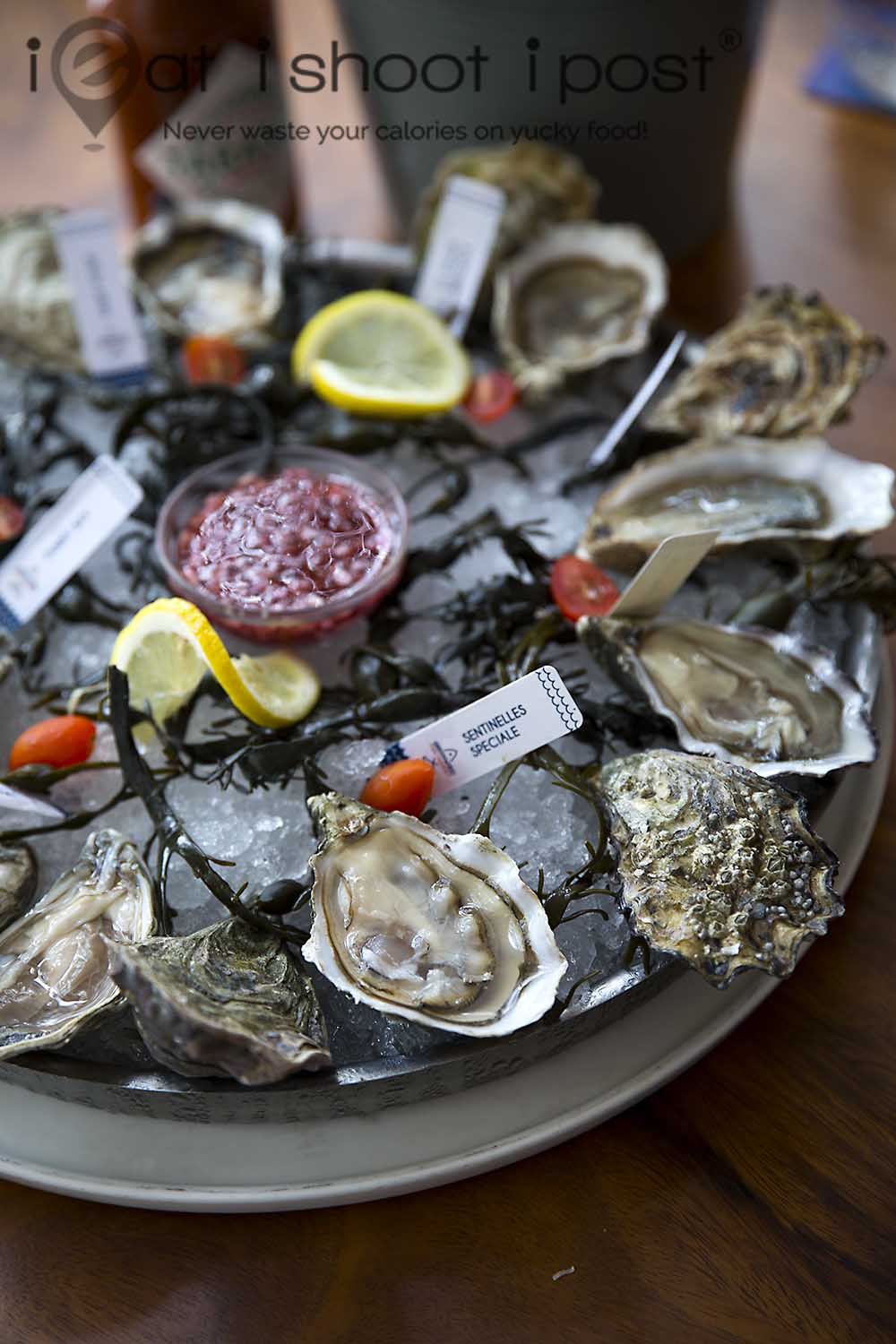
I had my oyster epiphany in Oct 2011 during an OSU trip to Boston to speak to the Singapore students there. When we were planning what to eat for lunch, my friend Jason suggested the Neptune Oyster Bar. My first reaction wasn’t one of unbridled joy. Up till then my only experience with oysters was at the hotel buffet and the rocky little bivalves weren’t on my list of favourite foods. But Jason was insistent that I should try it. He told me that oysters are much more interesting when you can try a few varieties side by side. It was a watershed moment and a significant milestone in my gastronomic journey!
In our local context, oysters are most commonly found in oyster omelettes and UFOs. They are generic oysters which usually comes frozen and eaten cooked. Eating a live oyster in its shell is a whole different experience! It’s the closest thing in the West to Japanese sushi. Not just because it is also eaten raw, but also because of the mystery of terrior (or in the case of marine creatures, merrior) where the taste is dependent on the place it comes from. For the foodie, that brings the particular delicacy to the next level. It is not longer just about how it tastes, but where it is grown and how it is cultivated. In other words, it has the all qualities the oyster geek needs to distance themselves from the casual oyster muncher!
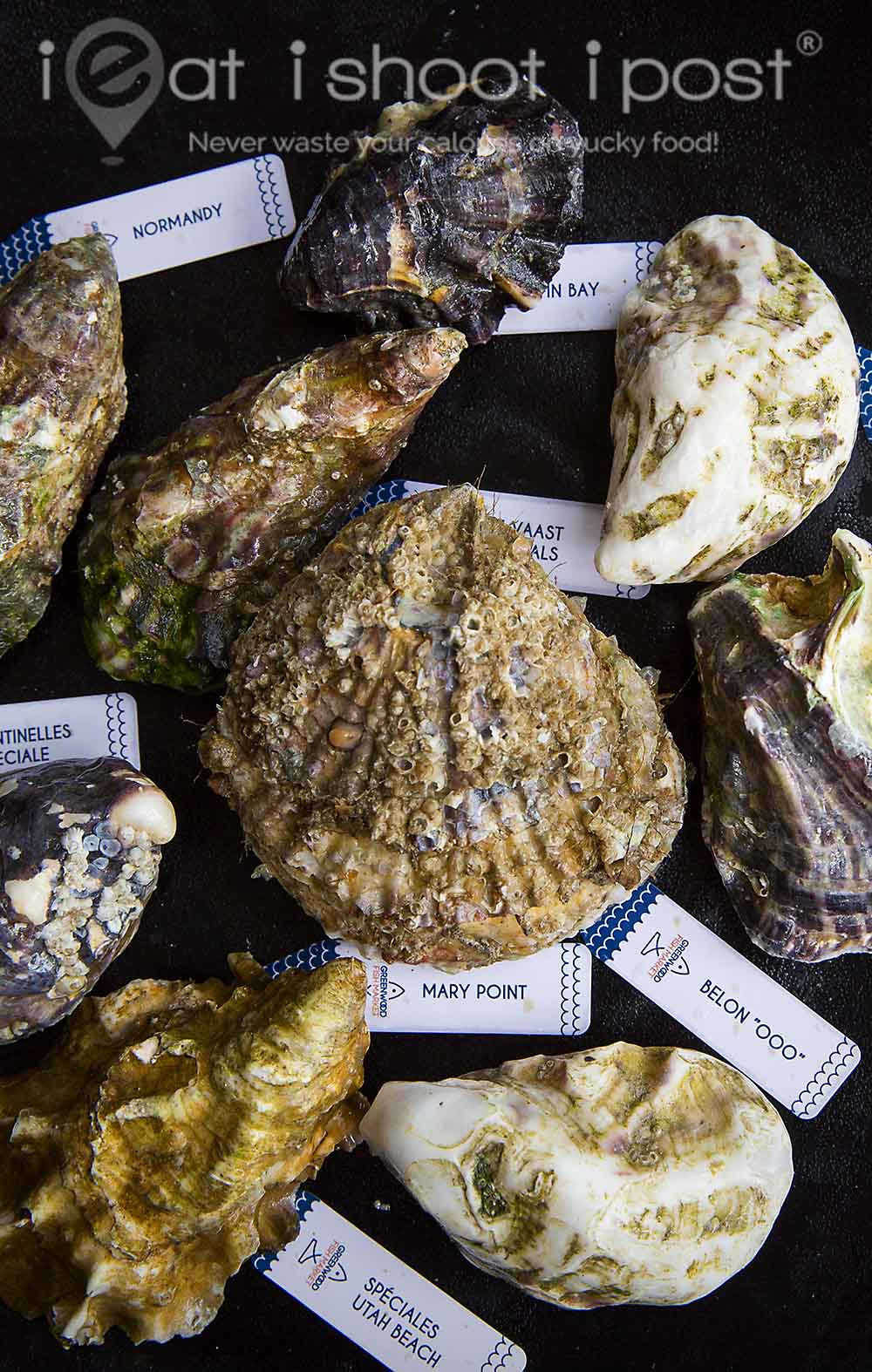
I am far from being an oyster geek. I haven’t eaten enough to be able deliver its eulogy just before sending the little mollusk on its final journey. However, in the last few weeks, I have learnt enough to be able to pen this “Idiots guide” so that you can sound like a pro at the oyster bar. After all, If you appear more like an oyster shucker than an oyster sucker then you’d probably end up with better oysters on your platter!
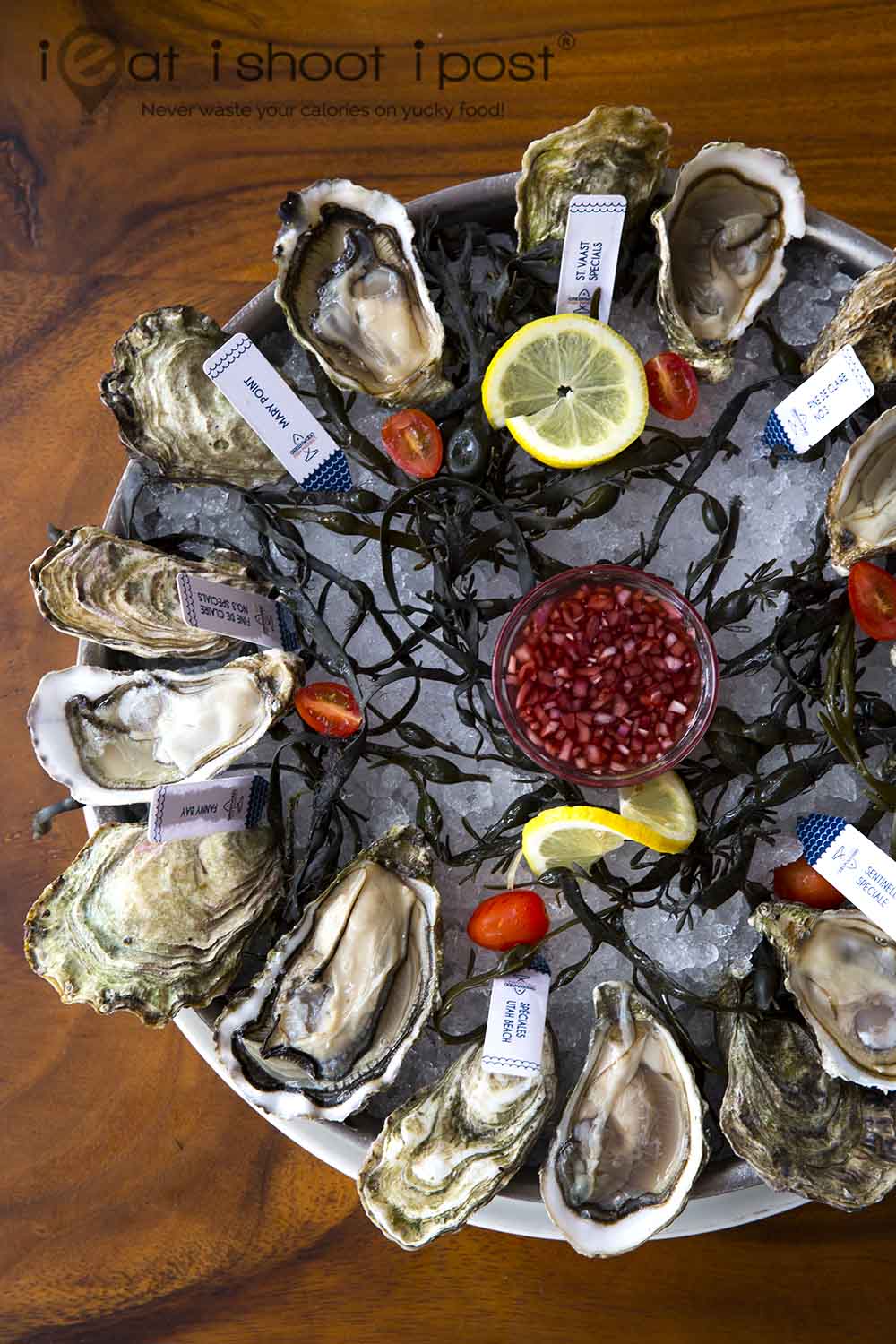
Some Basic Tips
1. There are five varieties of oysters that are commonly eaten. The most popular is the a. Pacific oyster, crassostrea gigas, which were originally from Japan but are now farmed all around the world. They grow quickly, reaching table size in three years and have nice deep cups which houses a plump oyster. Almost all the oysters in this post are Pacific oysters which the exception of the Belon which are b. European flats, ostrea edulis which are the native oyster of Europe. The native c. Eastern oyster, crassostrea virginica is commonly farmed along the North Atlantic coast of America. These were what I had at the Neptune oyster bar but are unfortunately not available at here at Greenwood Fish Market. There also the d. Olympia oysters, ostea lurida which are small oysters native to the Northern Pacific coast of America. These, too, are not available here. Finally, there are the e. Kumamotos, crassostrea sikamea which have quite a cult following. They are the only ones of the species and were originally from Kyushu island, Japan. Thankfully, they were transplanted to the US before they went extinct in their native waters. They are supposed to make their appearance at the festival but the supply this year has been erratic.

2. When tasting the oyster, first have a look at the SHELL. Note its shape and symmetry. High quality oysters are often coaxed into an ideal form from young, just like Miss Universe hopefuls from Venezuela. Next, have a look (SEE) at the oyster itself. Is it well shucked or did the oyster man make a crime scene of it. Is the oyster nice and plump or lean and meaty. Note its color, it should be a healthy greyish ivory color. If it is black, brown or pink, its gone bad. Now bring it up to the nose and SMELL it. You should smell a crisp ocean breeze. If it stinks, bring it back to the oyster-man. Next, have a SIP of the liquor. This is essentially the sea water in which the oyster was growing in just before it was rudely displaced from its cosy habitat and flown halfway across the globe. But it isn’t just sea water, it’s “liquor” because it’s what the oyster has been bathing in all this while. The liquor would either be very salty or not so salty depending on where it was finished. Next, SLURP the oyster, give it a bite and a few chews and note its texture: Is it crisp and creamy or lean and meaty. Note the flavour: Is it musky, nutty, buttery etc. Now SWALLOW and note the finish. Does it have a metallic, iodine finish or is it more like melon and cucumber. Now, make a mental note if this is an oyster you would like to order again!
3. It can be very intimidating to look at a list of 22 oysters and decide what to order. You have two options. You can go for the $99 for 9 pairs of oyster promotion and allow the oyster-man to offer you his selection and forever be an oyster noob or you can continue reading the rest of this article. I have arranged the oysters into 5 groups viz: Beginner’s, Luxury, Unique flavours, French style and Pacific North West. If you pick one or two oysters from each group, you would be able to have a good selection of oysters with a range of different flavours to enjoy!
4. When assessing the flavour of the oysters, we do have to bear in mind that they are seasonal creatures. In the spring, when they start feeding again, they tend to taste more green. In the summer, they spawn and spawny oysters have a milky, translucent liquid and doesn’t taste very good, although there are some people who do like them. After spawning they are skinny and quite tasteless. In the fall they start feeding and start storing food for the winter. It is said that an oyster in the winter months will taste the best. This seasonality gave rise to the rule that you should only eat an oyster during months with contain the letter “R” ie not during the summer months. However, nowadays oyster farmers are growing oysters that don’t spawn, which is why they are now available all year round. Having said that, they do still taste marginally better in the colder months! So, do bear this in mind and should you taste an oyster which you didn’t quite like, you might want to give it a few months and try it again before making a final decision!
Beginner’s Oysters
These oysters are generally well accepted because of their mild flavour and are good ones to start with, especially for those who don’t enjoy pungent flavours.
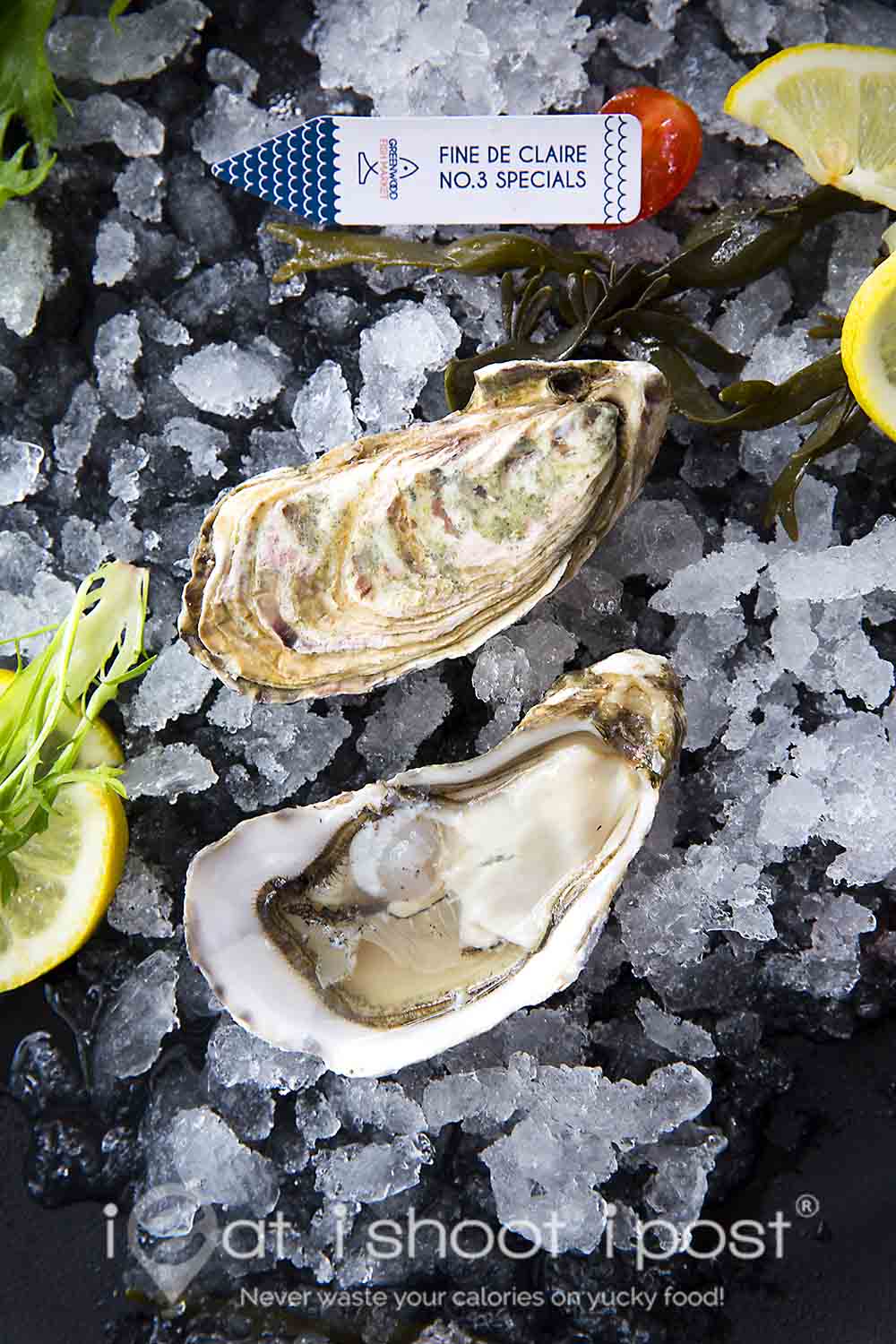
Name: Fine de Claire/Fine de Claire Specials
Species: Pacific Oyster, Crassostrea gigas
Location: Marennes-Oleron, France
Price: $5/$5.50
This is a very popular French oyster which is briny, meaty and flavourful. They are finished in clay salt ponds (claires) for at least a month where they become sweeter and more tasty. There are special ones whose gills are green in colour as they are finished in ponds with Blue Navicula algae. These are called Fine de Claire Verte and are supposed to be richer in flavour. (They don’t have these at the festival) The difference between the normal Fine de Claire and the Fine de Claire Specials is that the specials spend an extra month in the salt ponds and are less densely cultured, (10 oysters/m² instead of 20) which results in an oyster which is more plump and flavourful.
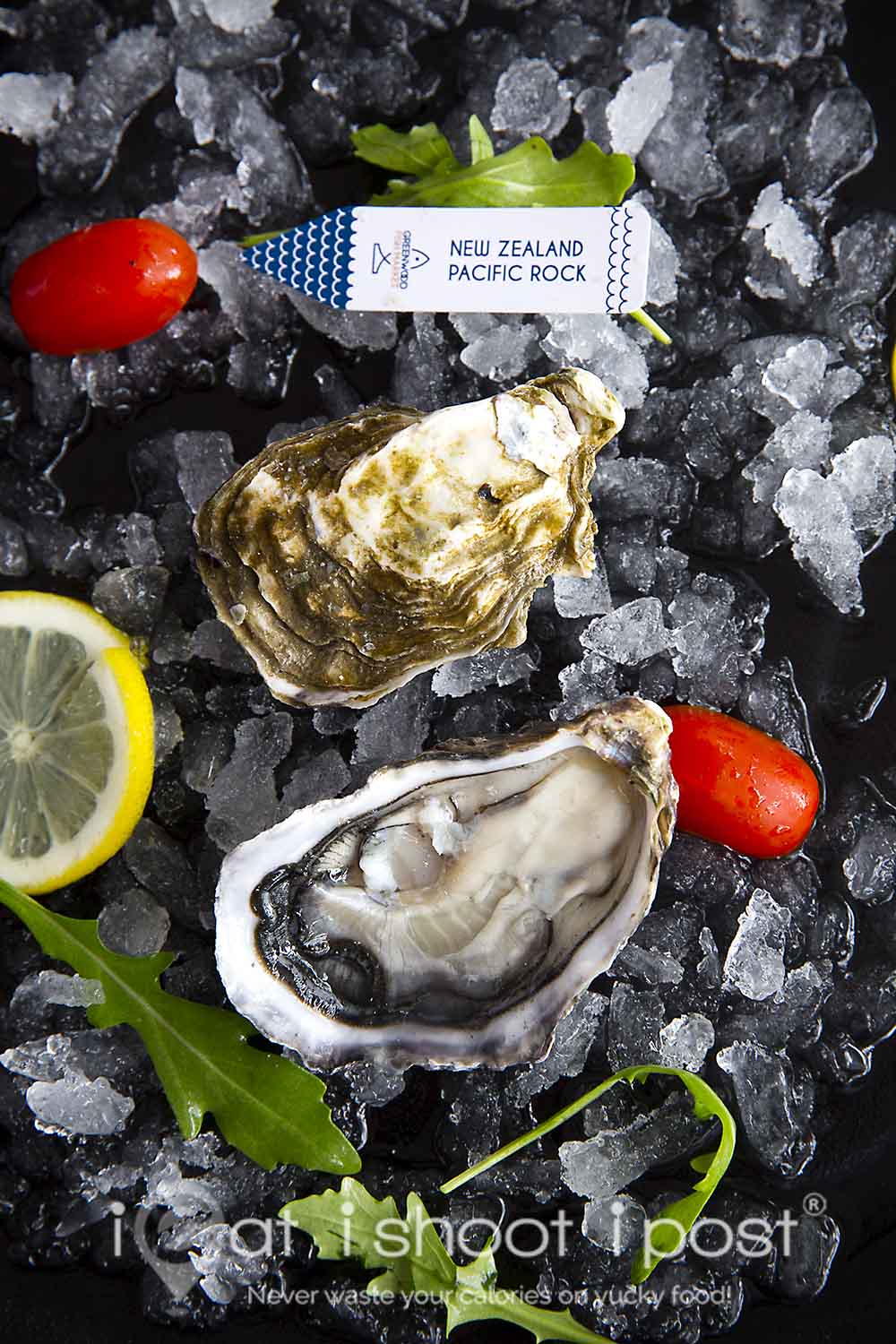
Name: New Zealand Pacific Rock Oyster
Species: Pacific Oyster, Crassostrea gigas
Location: North Island, New Zealand
Price: $4.50
The cultivation of the New Zealand Pacific Rock Oyster started in the 70s and quickly replaced the native New Zealand Rock Oyster (Saccostrea glomerata) as the main cultivated oyster. It’s clean, crisp and pleasant. The flavour is not complicated which makes it an easy oyster to start with.
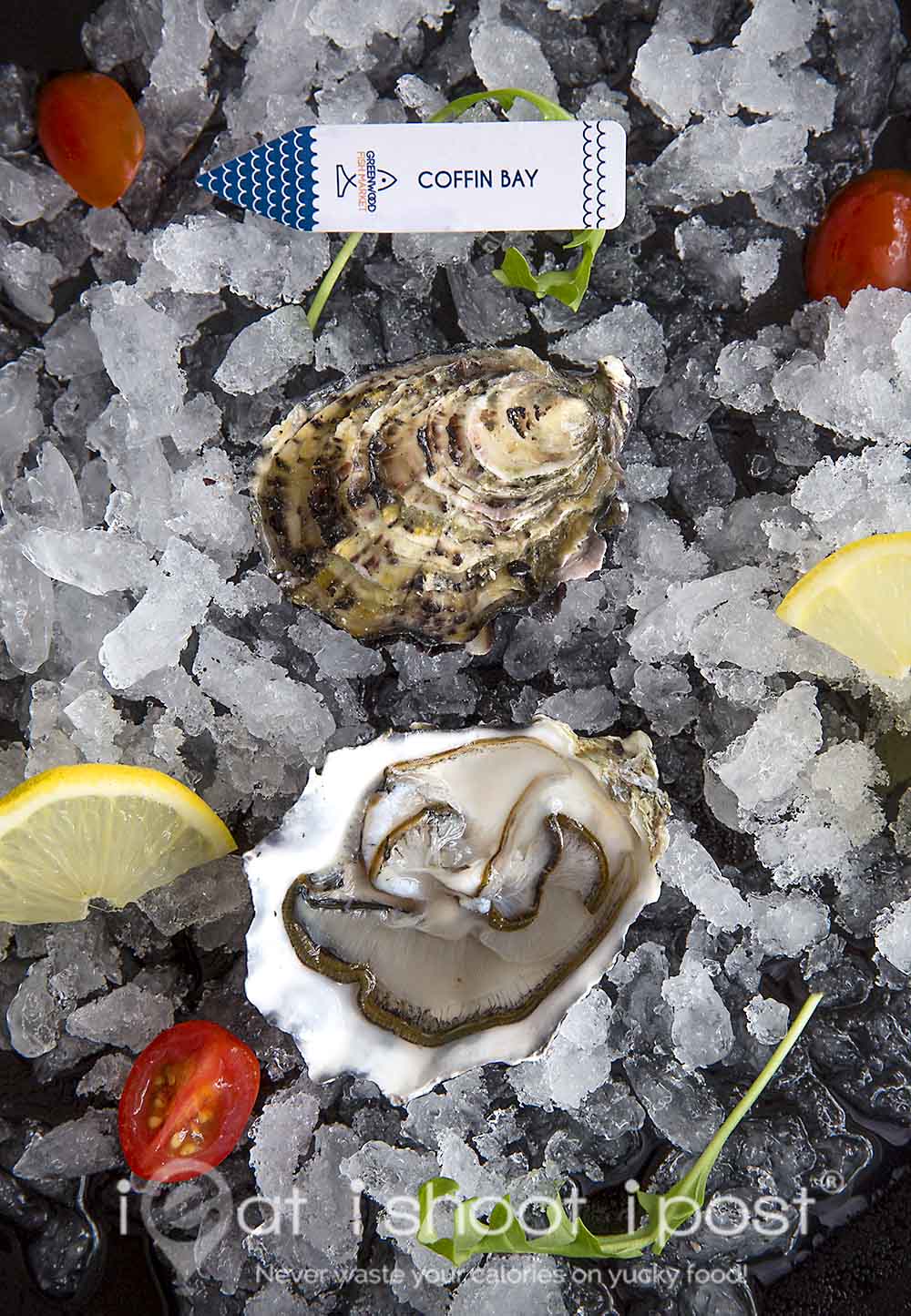
Name: Coffin Bay Oysters
Species: Pacific Oyster, Crassostrea gigas
Location: Coffin Bay, South Australia
Price: $5
These Australian oysters have quite a following. They are easily recognized by their petite size and rounded shells with black edges. They are briny, crisp and they have an unique and pleasant flavour which is quite pronounced, making them stand out from the crowd, but in a nice way. It is the only oyster among the selection which comes from the Antarctic ocean.

Name: Golden Mantle
Species: Pacific Oyster, Crassostrea gigas
Location: NE of Texada Island, Strait of Georgia, British Columbia
Price: $4
These oysters are farmed in mesh trays which are suspended in water for the whole of their lives, unlike most of the other oysters in this series which may be tumbled or exposed to tidal variations. As a result they grow very fast but the shells tend to be brittle. Because they never need to shut their shells tight, the muscles don’t need to exercise much which results in an oyster which is deeply cupped, plump and mildly flavoured. Somehow, I did find this oyster a little more chewy compared to the others.
Luxury Oysters
These are like the Wagyu of the oyster world where farmers will go through all lengths to carefully coddle the little mollusks to produce the perfect oyster. Take some time to admire the shape of the shells. They are specially cultivated to have that perfect teardrop shape with and tend to be wider than the normal oysters even though they might come from the same region. (Compare Gillardeau and Spéciales Utah Beach to Normandy and St Vaast)
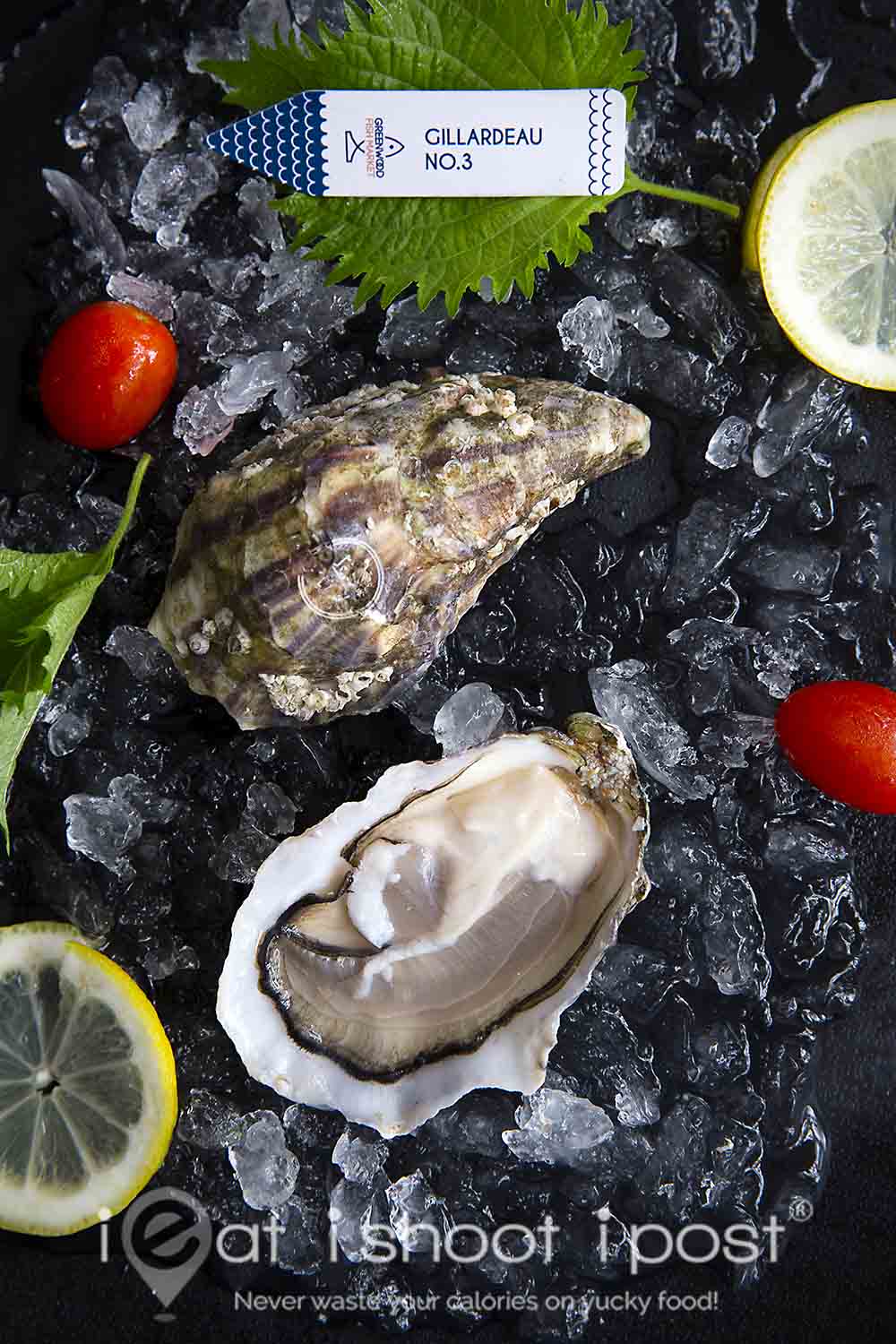
Name: Gillardeau No. 3
Species: Pacific Oyster, Crassostrea gigas
Location: Utah Beach, Normandy and County Cork, Ireland
Price: $9
These are widely regarded as the “Rolls Royce” of oysters and the gold standard for which other luxury oysters (like the ones below) aspire to. As such the company has even invested in a laser engraving machine so that each Gillardeau has the trademark “G” imprinted on its shells! They are cultivated by fourth generation French oyster farmers and are raised in Utah Beach or County Cork before being finished in salt ponds. To ensure that the oysters feed well, only 135-150 oysters are kept in oyster bags meant for 1000. The bags are turned every fortnight to stress and mold them into their ideal form.
These oysters are creamy, substantial, sweet with an intense umami that lingers for a while after you swallow. There is little not to like about it except for the price.
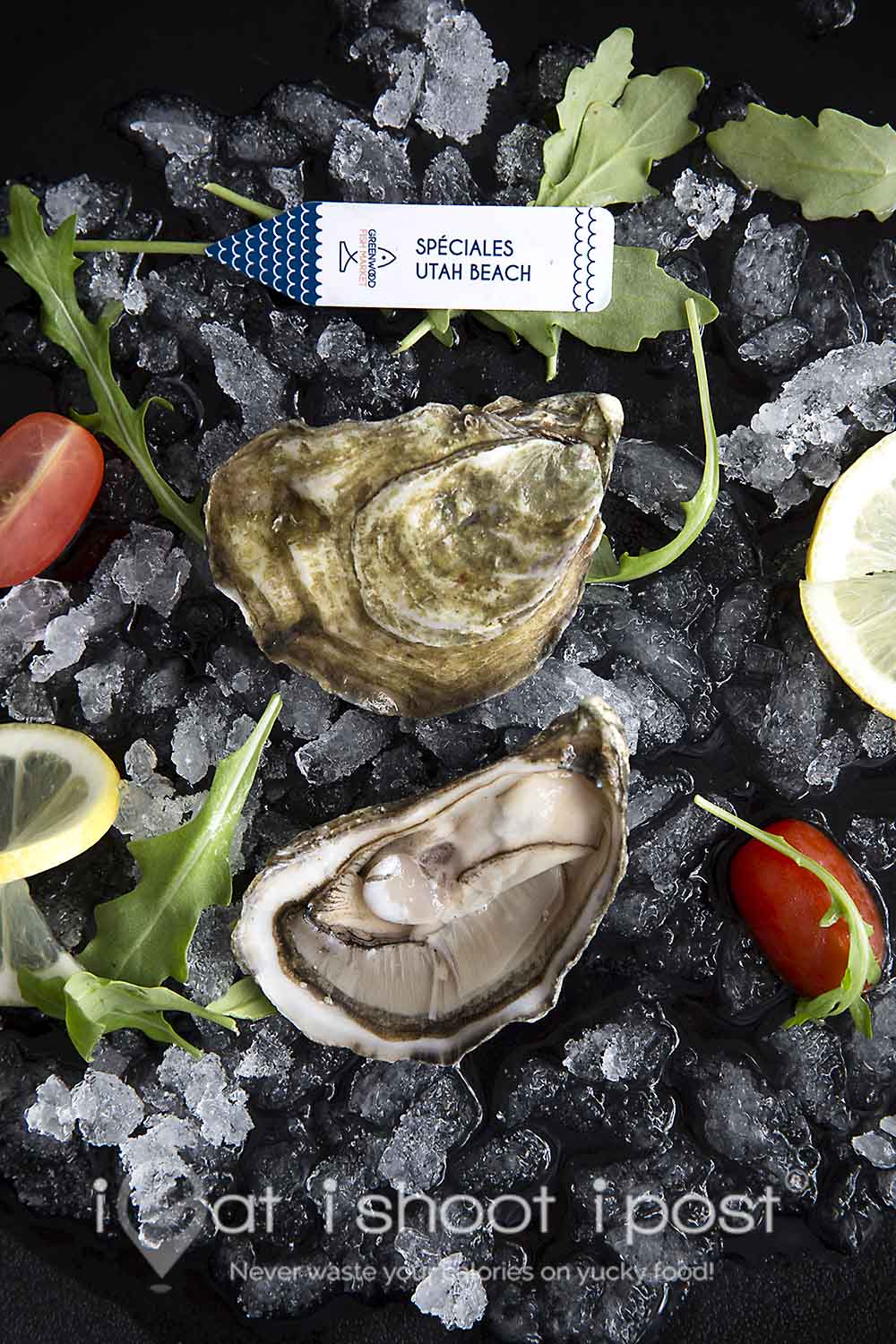
Name: Spéciales Utah Beach
Species: Pacific Oyster, Crassostrea gigas
Location: Utah Beach, Normandy
Price $7
Apart from from its role in WWII, Normandy is also famous for its oysters and produces 25% of the oysters in France. It has the strongest tides in Europe and the nutrient rich waters are ideal for oyster cultivation. The a fore-mentioned Gilladeaus are also farmed at Utah Beach. The flesh is plump, creamy and sweet, though not as distinctly sweet as the Spéciales Sentinelles.
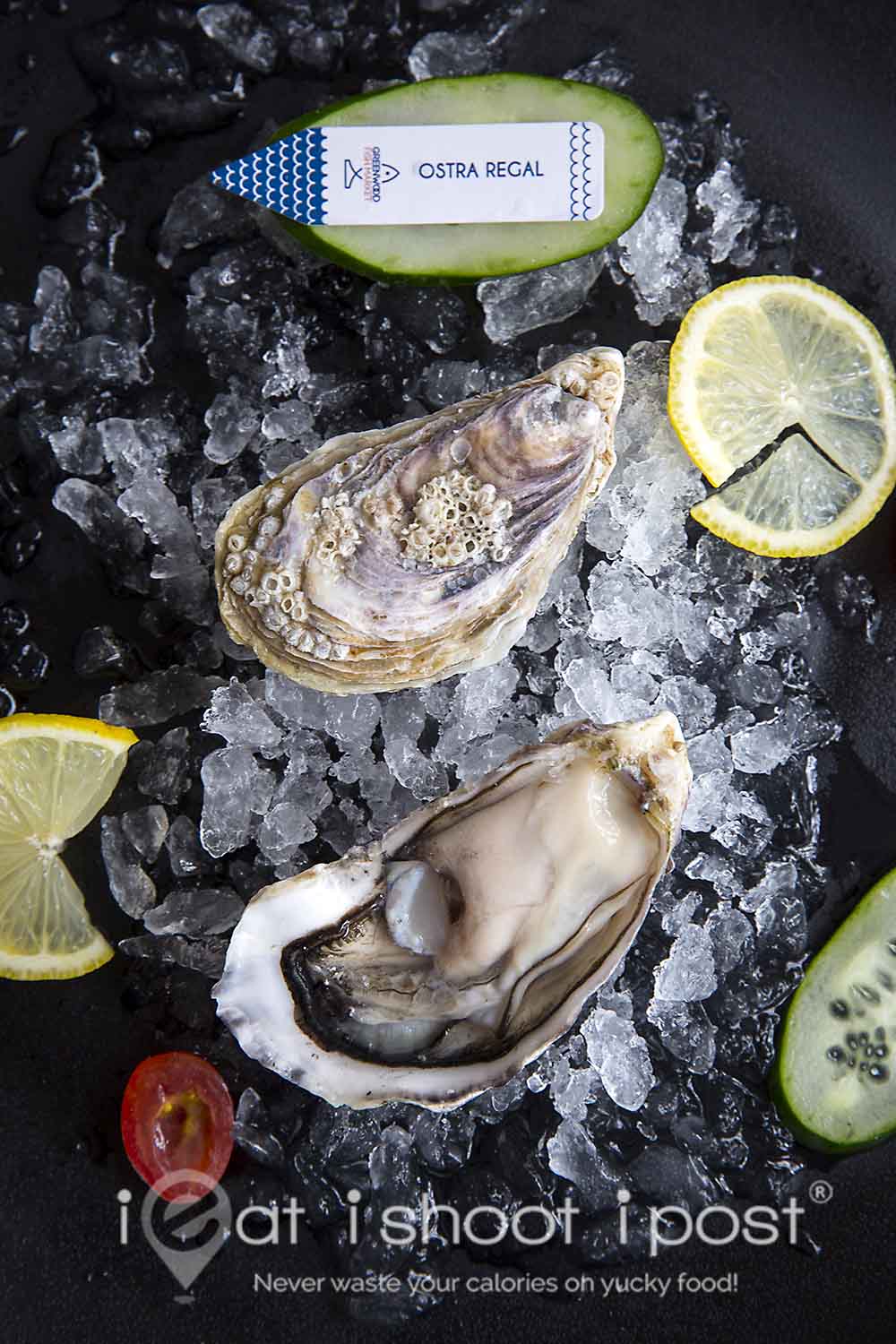
Name: Ostra Regal
Species: Pacific Oyster, Crassostrea gigas
Location: Bannow Cove, Ireland
Price: $7
Ostra Regals are the Irish answer to the Gillardeaus. The spats come from nurseries in France and are specially selected for slower growth and high meat to shell ratio. The meat is substantial and it has a distinct sweetness and a long finish. According to Alan, they are probably the best oysters being produced in Ireland.
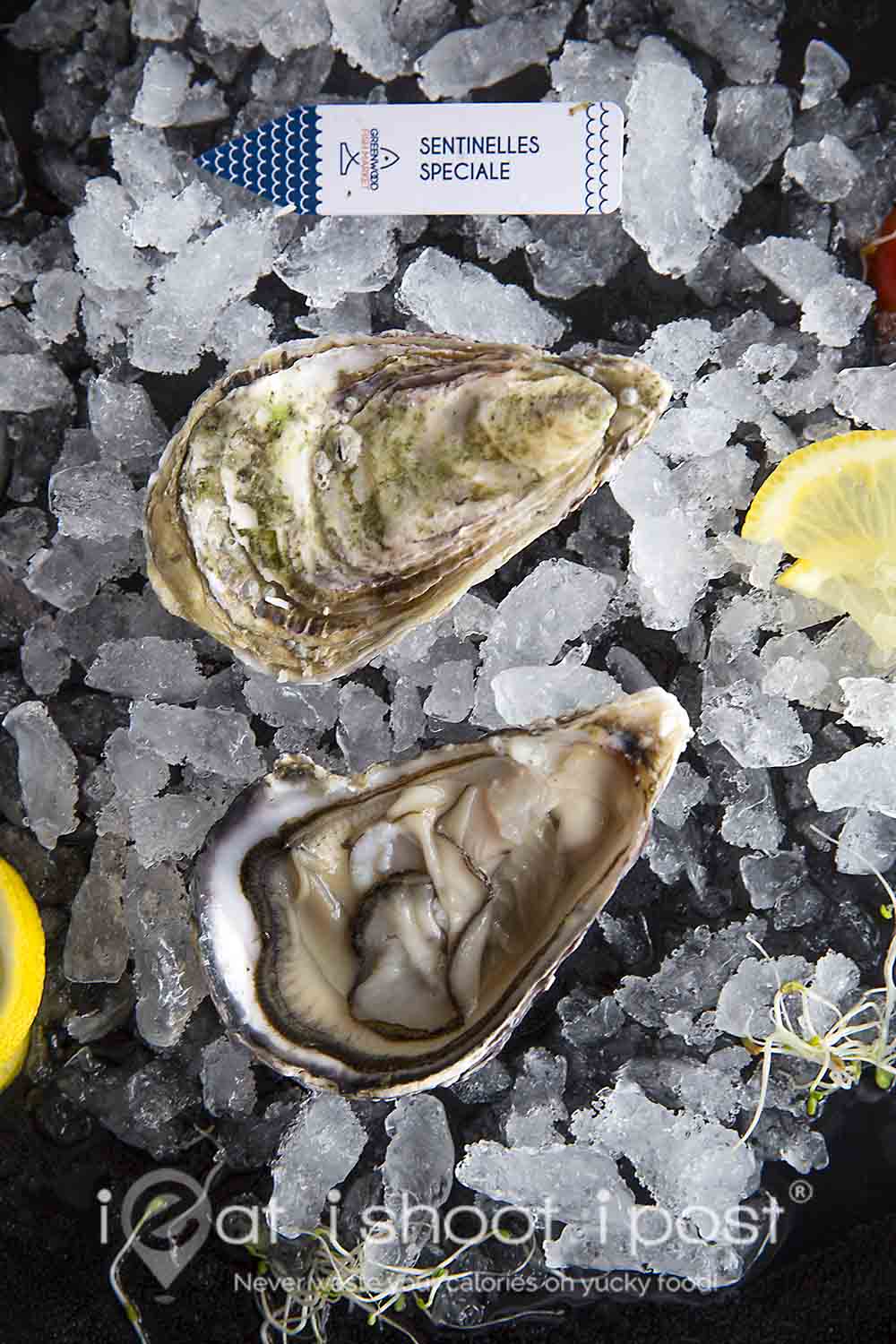
Name: Spéciales Sentinelles
Species: Pacific Oyster, Crassostrea gigas
Location: Ireland
Price: $6
Like the Ostra Regal, these are also farmed in Ireland from spats procured from nurseries in France. The liquor was less salty and intense. The meat was creamy and distinctly sweet.
Unique flavour/characteristics
These are oysters that have very unique flavours or characteristics which can be quite polarizing — like durians. Some people will go to the oyster bar specifically for them while others might find the flavour a little off putting. If you are a beginner, avoid starting your pilgrimage with these as they might just put you off oysters for life!
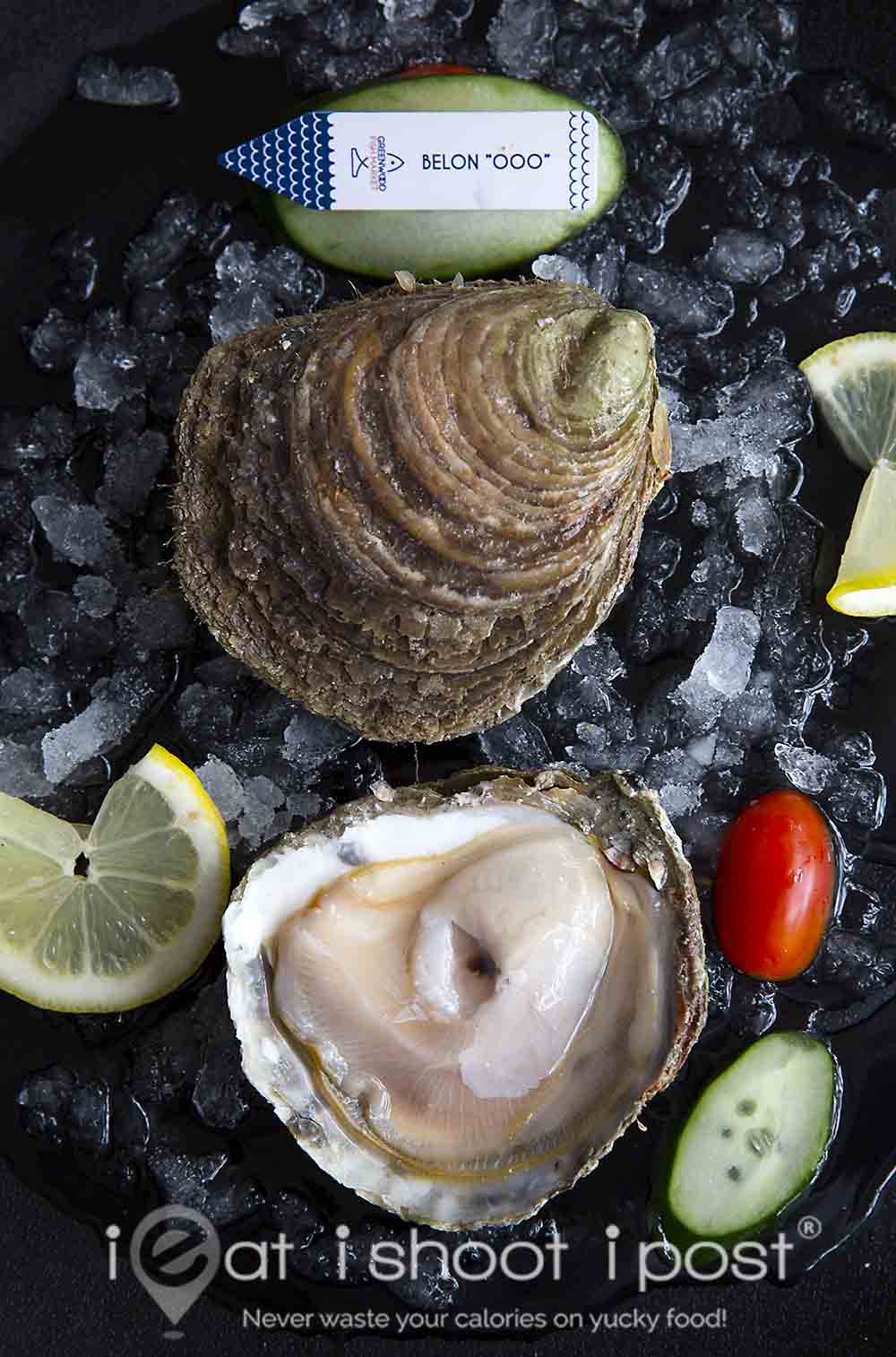
Name: Belon
Species: European Flat Oyster, Ostrea edulis
Location: Belon river, Brittany, France
Price: $8
Unlike the other oysters in this series, Belons are a different species that are native to Europe called the European Flat Oysters, Ostrea edulis . These are the ones that French were eating before they started cultivating the Pacific Oyster. In the 50’s, some European Flat oyster spats were transplanted from the Netherlands to Maine in North America and they started growing there. In France, the name “Belon” is protected by law and only European Flat Oysters that are actually grown in the Belon river have a right to the name.
These oysters are easily identified because of their rounded shape and shallow cup. It was my first time tasting them and the difference in flavour is quite obvious. They were not so salty, quite creamy with perhaps a little metallic finish. I am ambivalent about them, but it is a very different tasting oyster and they are not easy to come by, so if they are available, you should order them just so that you can contrast them with the rest of the Pacific oysters.
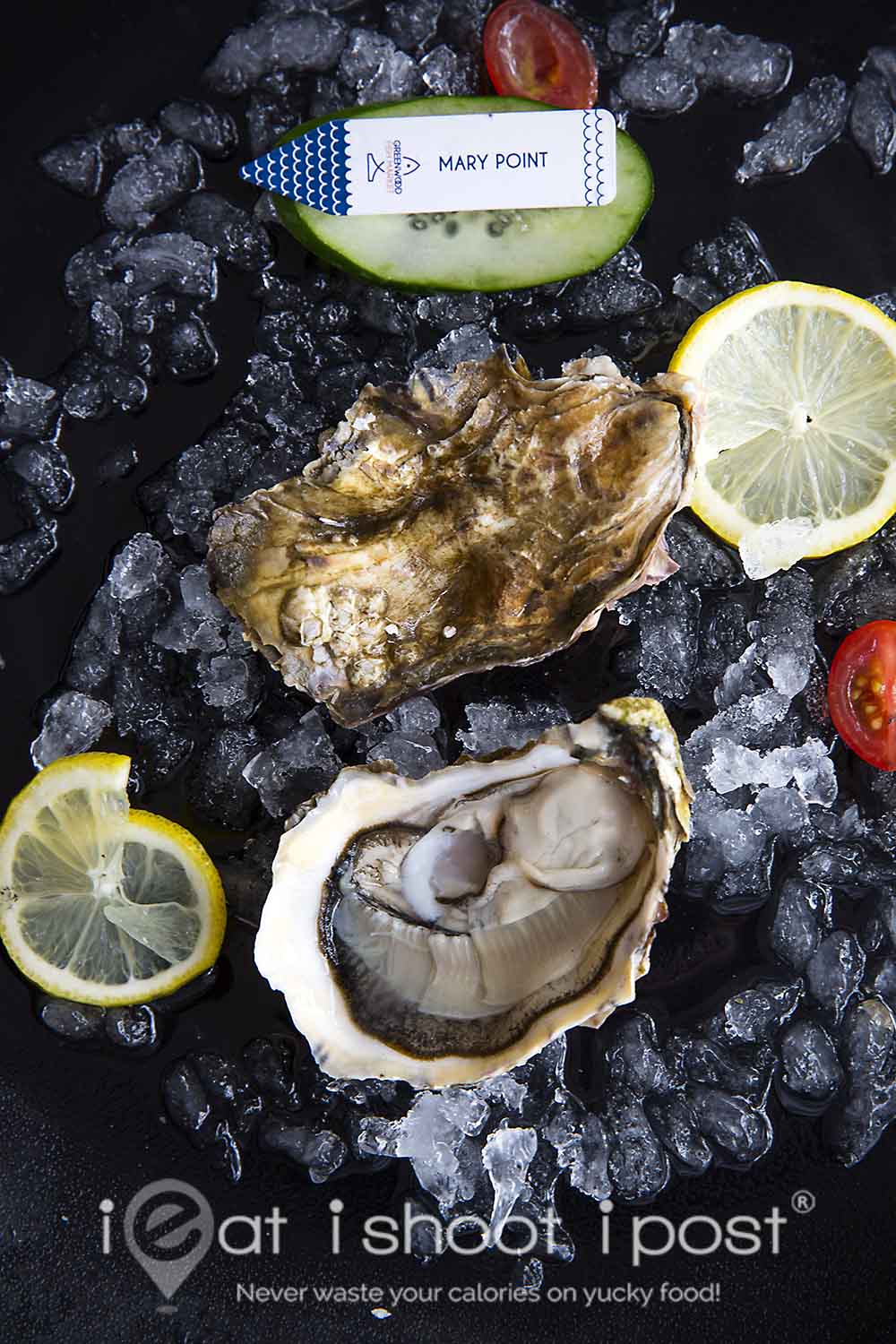
Name: Mary Points
Species: Pacific Oyster, Crassostrea gigas
Location: Baynes sound, British Columbia, Canada
Price: $4
There are some people who would just go for Mary Points and refuse to eat anything else. Others, like myself, found them to be pretty awful the first time I ate them. They have a particular musky scent about them which you either love or hate. That alone justifies their place on your plate. I must admit though, that they weren’t as awful the 2nd time I tried them, although I am still not a fan. Maybe it is one of those things that will grow on you after a while.
The oysters are raised on the beach where they are subjected to tidal variations. During low tides, they have to shut tight to keep the water in and to fend off natural predators. This toughens up the oyster and the shells become hard while the flesh gets more flavourful.
French style oysters
The French have a long history of oyster cultivation and produce some of the most sought after oysters in the world! French oysters from the northern coast tend to be meaty, briny and more intense with a metallic/iodine finish. There are a few oyster growing regions in France. The following oysters come mainly from Brittany, Normandy and the Southeastern coast of Ireland and have similar flavour profiles.
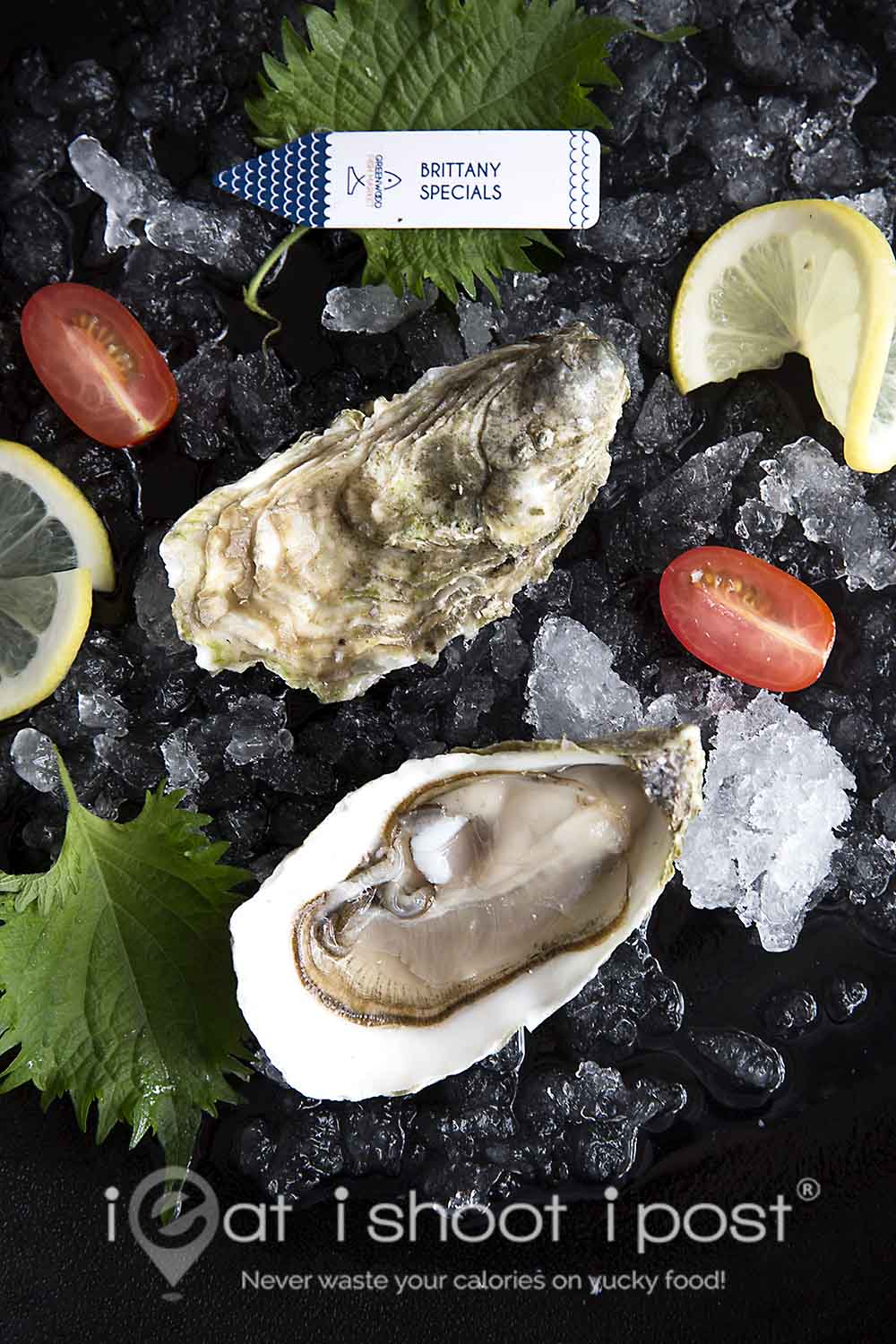
Name: Brittany Spéciales
Species: Pacific Oyster, Crassostrea gigas
Location: Brittany, France
Price: $5
It is said that the people of Brittany eat more oysters per capita than anyone else in the world. That being the case, the oysters from the region must be pretty good. Belons also come from Brittany but specifically from the Belon river and they are the native species. These Brittany Spéciales are Pacific Oysters which are farmed off the coast. They are briny, creamy, sweet, and have a slightly metallic aftertaste.
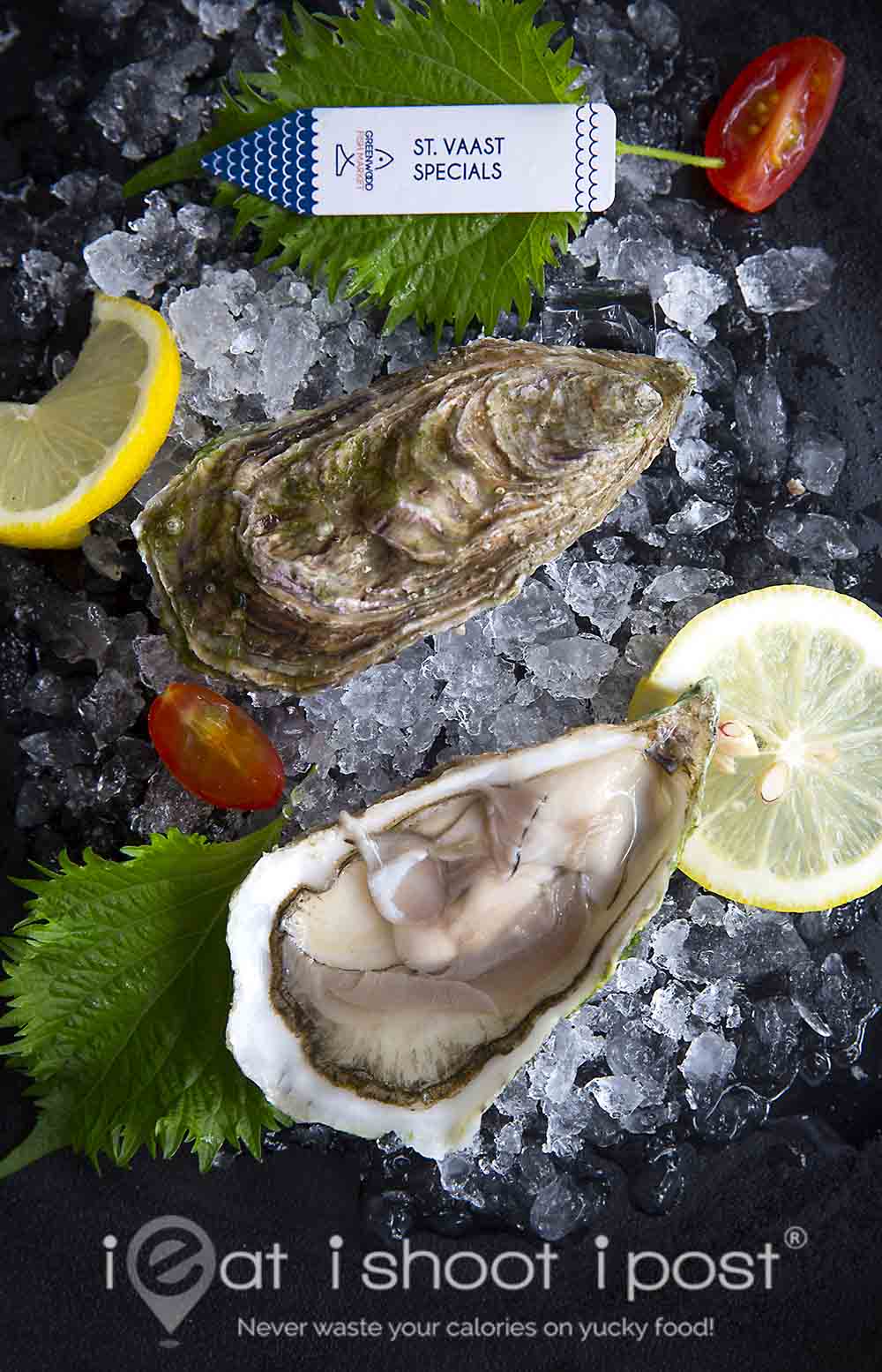
Name: St Vaast Spéciales
Species: Pacific Oyster, Crassostrea gigas
Location: Normandy, France
Price: $5
St Vaast la Houge basin is the oldest oyster farming region in Normandy. Located at the eastern side of the Contentin peninsula, strong sea currents bring nutrient rich waters to the area. The oysters are plump, with intense umami and a metallic/ iodine finish.
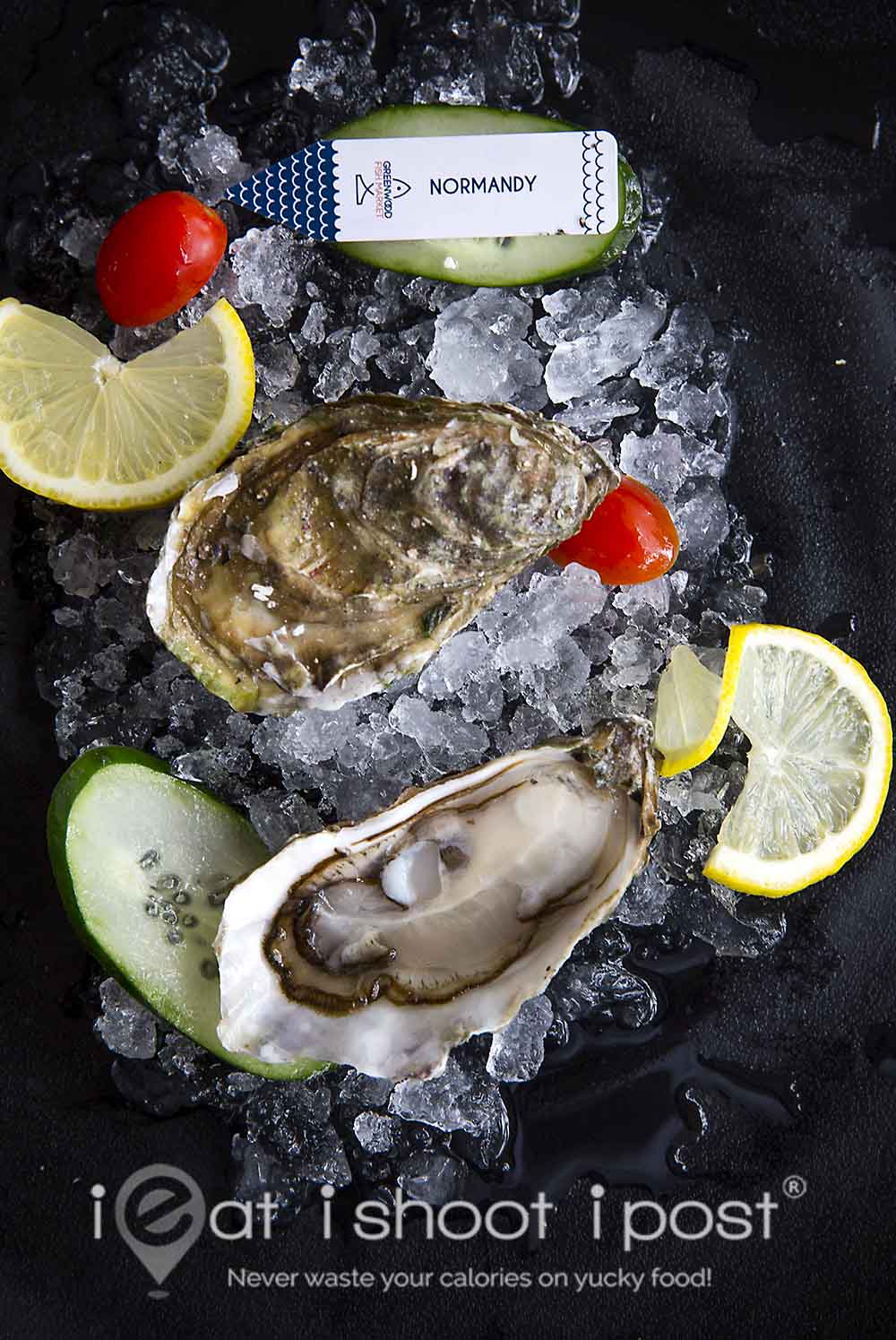
Name: Normandy
Species: Pacific Oyster, Crassostrea gigas
Location: Normandy, France
Price: $5
The region of Normandy grows 25% of the oysters in France including the famed Gilladeau oyster. They are plump, creamy and end with a metallic finish.
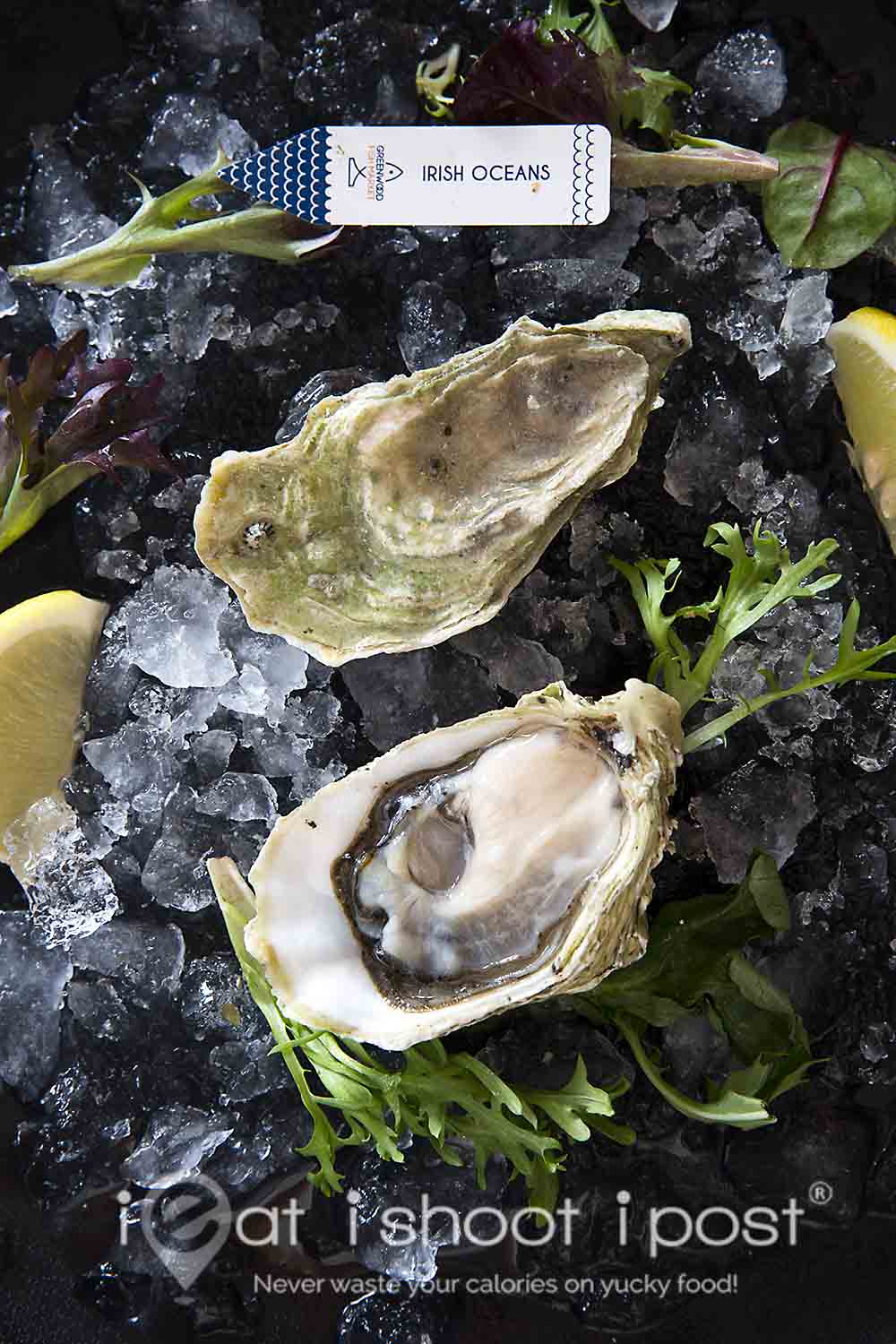
Name: Irish Ocean
Species: Pacific Oyster, Crassostrea gigas
Location: Poulnasherry Bay, Ireland
Price: $4.50
The farming of the Pacific Oyster in Ireland only started in the 1980’s and there are just 128 oyster farms in Ireland. However, the Irish have already gained a reputation for producing some of the best oysters and a lot of them are being exported to France. The southern coast of Ireland is located opposite Brittany and Normandy and its proximity also means that many French oyster farmers actually farm their oysters in Ireland.
The Irish oceans come from Moyasta oyster farm in Poulnasherry Bay (at the mouth of river Shannon half way between Kilkee and Kilrush) Being at the mouth of the river, the liquor is less salty and the oysters were bright. crisp and creamy and left a very good impression.
Pacific West Coast Oysters
Compared to the French oysters, the oysters from the Pacific West Coast tend to be milder in flavour, sweeter and more meaty. Most connoisseurs will typically say that they have the flavour of melon and cucumber.

Name: Barron Point
Species: Pacific Oyster, Crassostrea gigas
Location: Little Skookum Inlet, South Puget Sound, Washington State, USA
Price: $7
These oysters have the distinction of being the largest oysters of the selection brought in for the oyster festival. I had to take at least three bites to finish it. They are very plump and creamy with a mild flavour. I personally prefer the smaller oysters which you can finish in one bite but with these ones you really get a lot more oyster for your dollar!
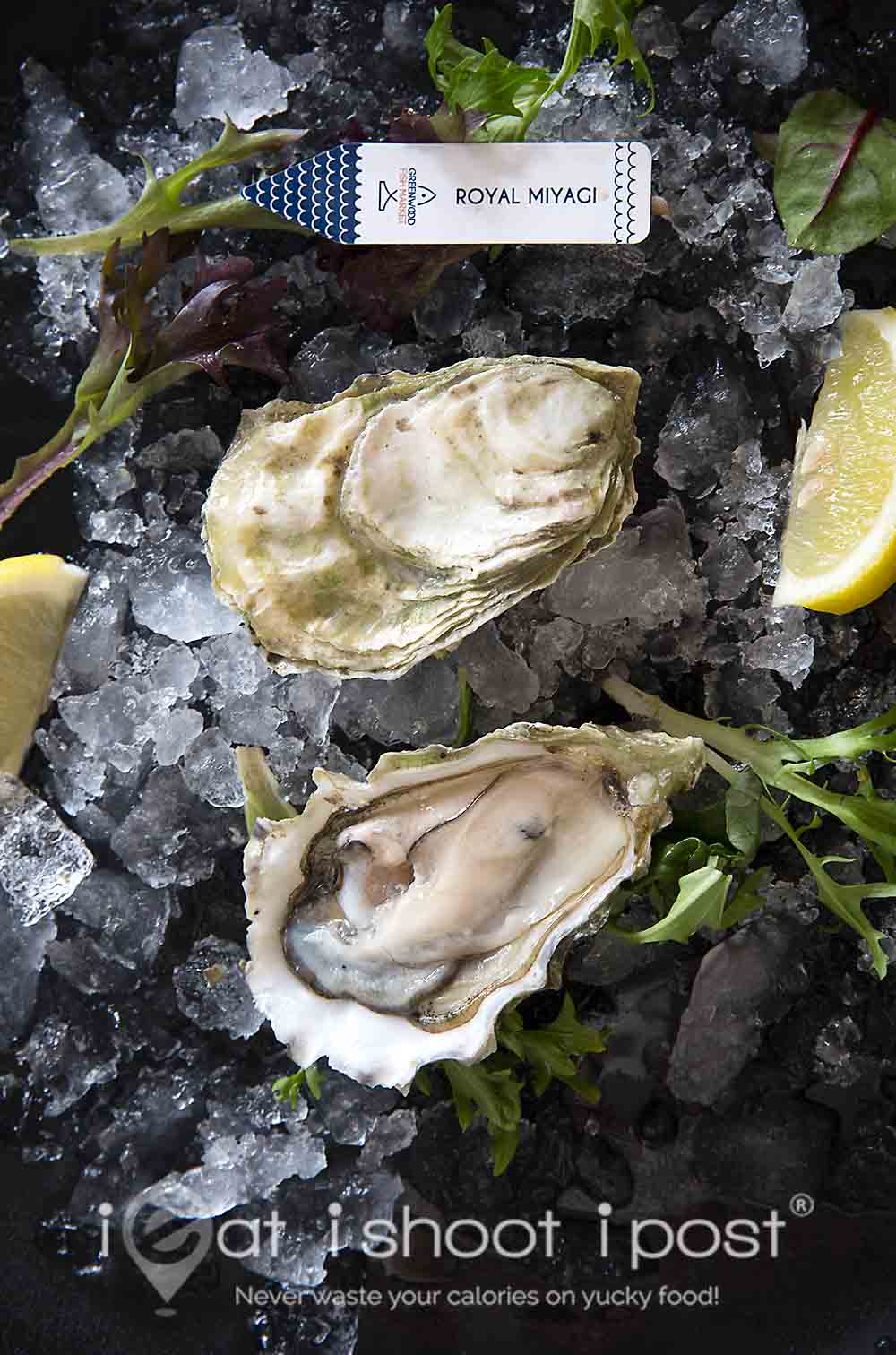
Name: Royal Miyagi
Species: Pacific Oyster, Crassostrea gigas
Location: Sunshine Coast, British Columbia
Price: $5
These oysters are first suspended on a line and then for the last 6 months finished on the beach where the flesh becomes firmer and the shells less brittle. The liquor is less salty and the flesh is crisp and mild.
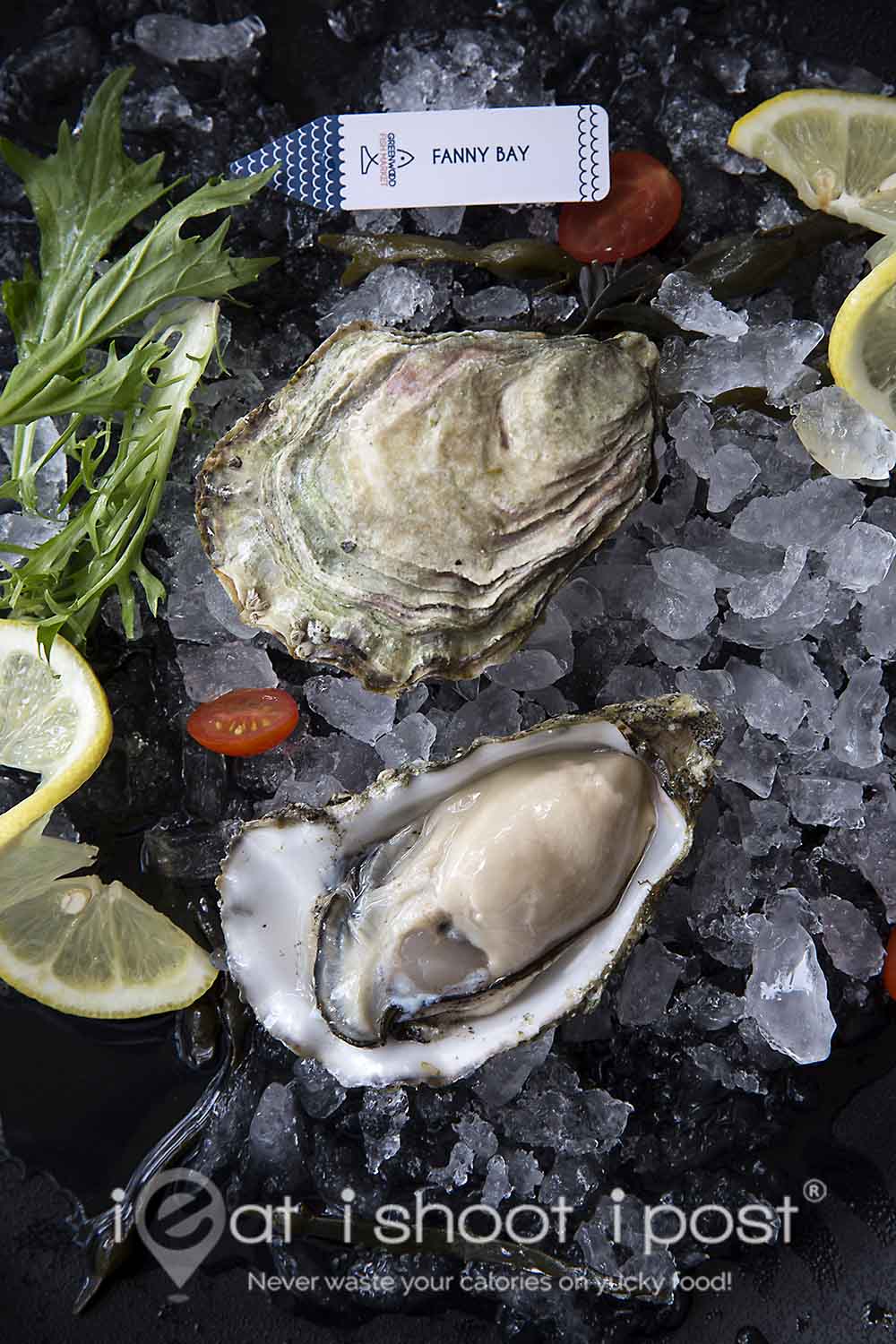
Name: Fanny Bay
Species: Pacific Oyster, Crassostrea gigas
Location: Baynes Sound, east Vancouver Island, British Columbia
Price: $4
Like the Royal Miyagis, these are also farmed in the British Columbia oyster appellation around Vancouver island. The pristine fjords is surrounded by snow capped mountains where the water is cold and unpolluted. These oysters are crisp, creamy and mild. The particular oyster I had was delightful as it was plump and more substantial then the French oysters.
Greenwood Fish Market’s 6th Annual World Oyster Festival
The world oyster festival is an annual event organized by the Greenwood Fish Market which takes place in the month of July. During the festival, 22 oyster varieties are brought in from across the globe and they are offering a selection of 9 pairs of oysters for $99. The oysters will be available at all Greenwood Fish Market restaurants including Bukit Timah, Valley Point, Sentosa and the newly opened restaurant at Dempsey.
Acknowledgement and Disclosure
This article was done with the help of Greenwood Fish Market and the oysters were provided as part of a media tasting. No fee was charged for writing this article.




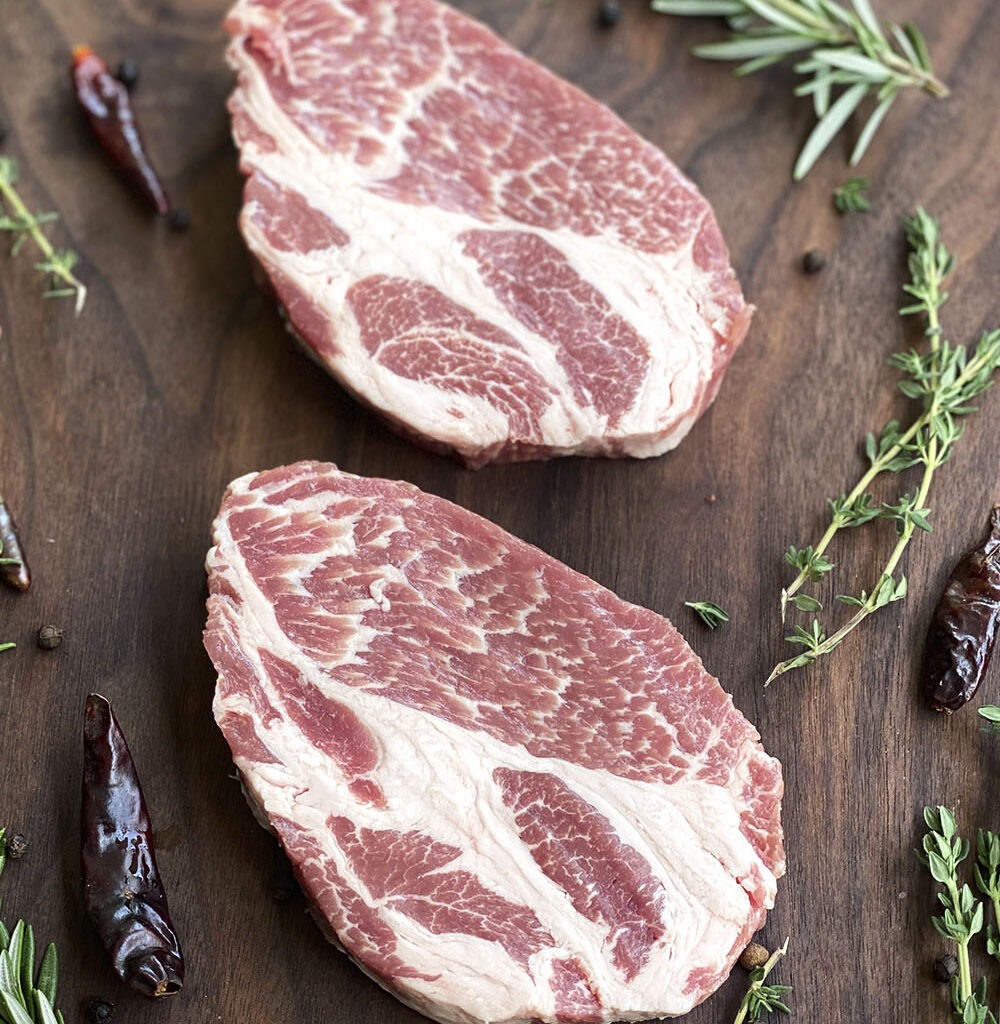
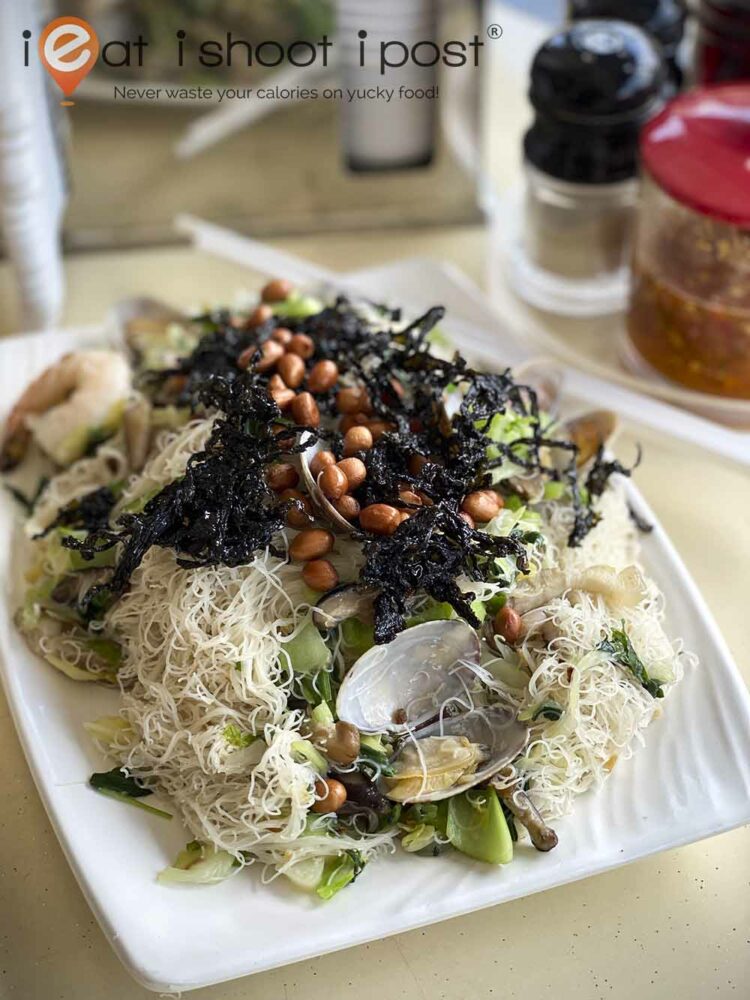
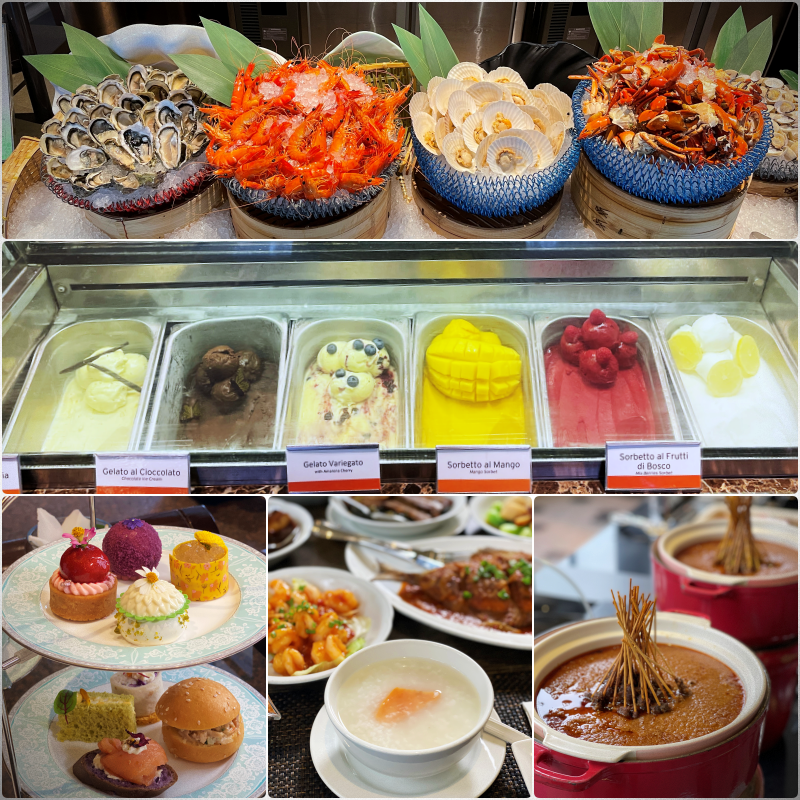
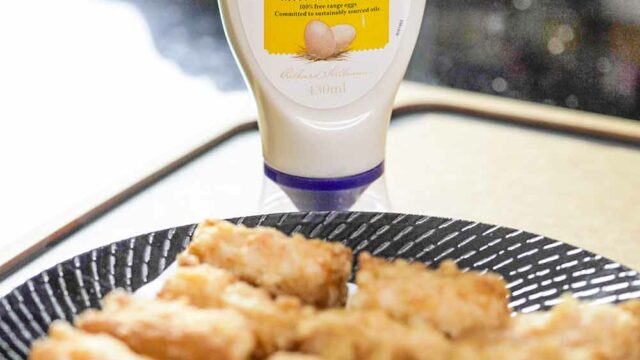




I hope I can be given the opportunity to win the giveaway to sample the oyster platter.
I would like to try the Baron Point oysters because I really like plump and big oysters.
I would also want to try the Gillardeau No. 3 because I have never tasted it before and would like to find out why is it considered the “Rolls Royce” in the oyster world.
Lastly, I want to try the Belon because they look so unique!
Hi Boon Lee, please write your comments on the Facebook Page! That is where we will be picking the winners from!
No, I haven’t, unfortunately.